Advertisements
Can Cats Eat Strawberries? Health Benefits, Risks, Feeding Tips, and What to Do If They Eat Too Many
Hi, I'm Riley! As a Canadian pet owner with both feline and canine companions, I frequently research safe human-food options for my pets. Strawberries, while a healthy snack for humans, raise important questions when it comes to feline nutrition.
After consulting with veterinary experts and reviewing current animal nutrition studies, I've created this comprehensive guide to address common concerns.
This evidence-based resource provides cat owners with the necessary information to make informed decisions about occasionally sharing strawberries with their feline friends.
Table of Contents
- Can Cats Eat Strawberries? The Basics Explained
- Are Strawberries Good for Cats' Health? The Nutritional Perspective
- What Are the Risks of Feeding Strawberries to Cats? Understanding the Potential Dangers
- How to Safely Feed Strawberries to Cats? Tips and Tricks for a Happy Cat
- How Many Strawberries Can Cats Eat? A Guide to Portion Control
- What to Do If Your Cat Eats Strawberries? Emergency Preparedness for Cat Owners
- What Fruit Is Cat Safe? Exploring Alternative Treats for Your Feline Friend
- Q&A Section: Common Questions About Cats and Strawberries
Can Cats Eat Strawberries? The Basics Explained
As a cat parent, I’ve often found myself staring at my bowl of strawberries and wondering, “Can cats eat strawberries?” It’s a question that pops up more often than you’d think, especially during summer when these juicy red fruits are in season. The short answer? Yes, cats can eat strawberries, but there’s a lot more to unpack here. Let’s dive into the nitty-gritty of feline fruit consumption.
The Natural Curiosity of Cats
Cats are notorious for their curiosity, and their noses often lead them to investigate whatever we’re munching on. Strawberries, with their bright color and sweet aroma, are no exception. But just because they show interest doesn’t mean it’s always safe or beneficial. As a rule of thumb, it’s essential to understand what our feline friends can and cannot eat to keep them healthy and happy.
Nutritional Profile of Strawberries
Strawberries are packed with vitamins like C and K, fiber, and antioxidants. For humans, these are fantastic health boosters. But when it comes to cats, their dietary needs are vastly different. Cats are obligate carnivores, meaning their bodies are designed to thrive on a diet primarily composed of meat. So, while strawberries aren’t toxic, they don’t offer the same nutritional benefits to cats as they do to us.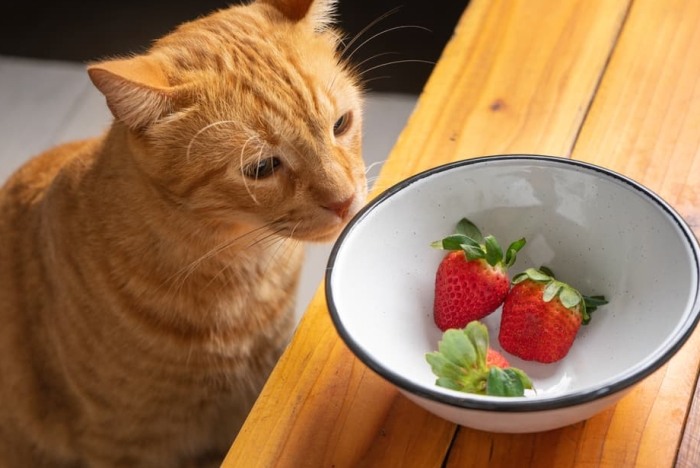
Are Strawberries Good for Cats' Health? The Nutritional Perspective
Now, let’s tackle the big question: Are strawberries good for cats' health? As mentioned earlier, cats have specific dietary requirements that strawberries don’t fully meet. But that doesn’t mean they’re entirely without merit.
Potential Health Benefits
Strawberries contain antioxidants, which can help combat free radicals in a cat’s body. These antioxidants might support overall health, though the extent of their benefit is minimal compared to a balanced, meat-based diet. Additionally, the fiber in strawberries could aid in digestion, but again, it’s not a significant source of dietary fiber for cats.
Hydration Factor
Strawberries have a high water content, which could contribute to a cat’s hydration, especially if they’re not big drinkers. However, it’s essential to ensure that strawberries are offered as a treat and not as a primary source of hydration. Fresh water should always be available to your cat.
Moderation is Key
While strawberries aren’t harmful in small quantities, they should never replace a cat’s regular diet. A balanced, meat-based diet is crucial for a cat’s health, and treats like strawberries should only make up a tiny percentage of their overall intake. So, are strawberries good for cats' health? Yes, but only in moderation and as an occasional treat.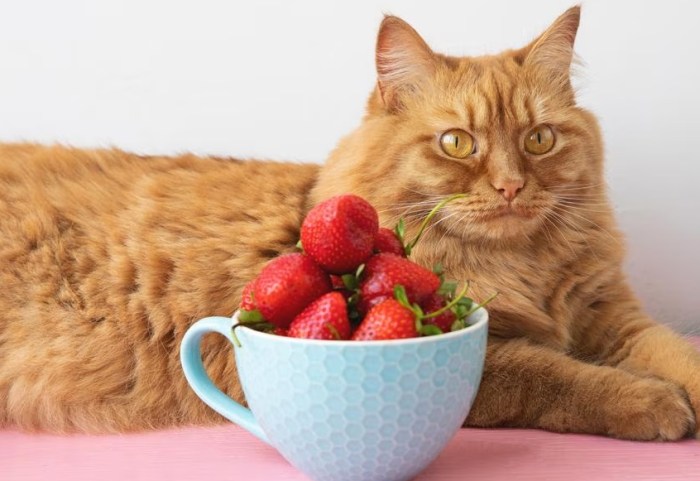
What Are the Risks of Feeding Strawberries to Cats? Understanding the Potential Dangers
Now that we’ve established that cats can eat strawberries and that they might offer some minor health benefits, let’s talk about the risks. What are the risks of feeding strawberries to cats? It’s a crucial question that every cat owner should ask.
Digestive Upset
Cats have sensitive digestive systems, and introducing new foods, even in small amounts, can sometimes lead to digestive upset. Symptoms might include vomiting, diarrhea, or a loss of appetite. If your cat shows any of these signs after eating strawberries, it’s best to avoid offering them in the future.
Allergic Reactions
Just like humans, cats can have allergic reactions to certain foods. While strawberries aren’t a common allergen for cats, it’s possible for them to have an adverse reaction. Signs of an allergic reaction might include itching, swelling, or difficulty breathing. If you notice any of these symptoms, seek veterinary care immediately.
Choking Hazard
Strawberries, especially if they’re large or not cut into small pieces, can pose a choking hazard for cats. Cats don’t chew their food as thoroughly as humans do, so it’s essential to ensure that strawberries are cut into bite-sized pieces to prevent any accidents.
Pesticide Residue
Non-organic strawberries might contain pesticide residue, which can be harmful to cats. Always wash strawberries thoroughly before offering them to your cat, and consider buying organic if possible to minimize exposure to harmful chemicals.
Sugar Content
While cats don’t taste sweetness the same way humans do, strawberries still contain natural sugars. Too much sugar can lead to weight gain, dental issues, and even diabetes in cats. It’s another reason to limit the amount of strawberries you offer to your feline friend.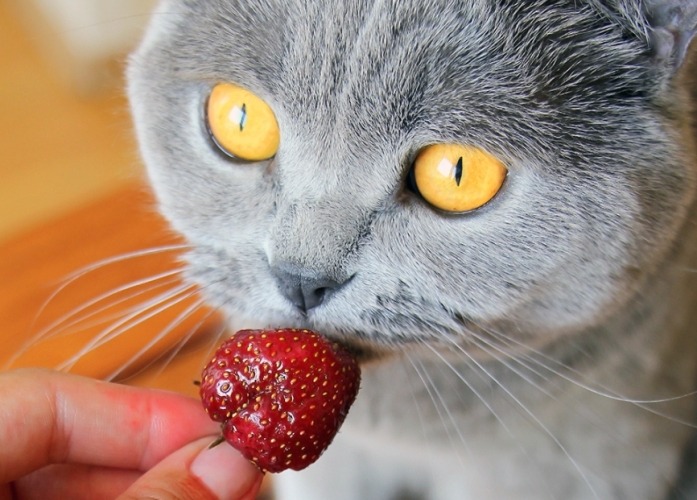
How to Safely Feed Strawberries to Cats? Tips and Tricks for a Happy Cat
Okay, so we’ve established that cats can eat strawberries, and we’ve talked about the risks. Now, let’s get into the nitty-gritty of how to safely feed strawberries to cats. As a cat owner, I’ve learned a few tricks along the way, and I’m excited to share them with you.
Wash Thoroughly
First and foremost, always wash strawberries thoroughly before offering them to your cat. This helps remove any dirt, pesticides, or other contaminants that might be on the surface. I like to use a vegetable brush to gently scrub the strawberries under running water.
Cut into Small Pieces
To prevent choking and make it easier for your cat to eat, cut strawberries into small, bite-sized pieces. I usually cut them into quarters or even smaller, depending on the size of the strawberry and my cat’s mouth.
Offer as a Treat
Remember, strawberries should only be offered as a treat and not as a regular part of your cat’s diet. I like to give my cat a few pieces of strawberry as a special treat on occasion, but I never replace her regular meals with them.
Monitor for Reactions
After offering strawberries to your cat for the first time, keep an eye on them for any signs of digestive upset or allergic reactions. If everything goes well, you can continue offering them in moderation. But if you notice any adverse effects, it’s best to avoid strawberries in the future.
Combine with Other Treats
To make strawberries more appealing to your cat, you can try combining them with other cat-safe treats. For example, I sometimes mix a few pieces of strawberry with some catnip or freeze-dried chicken treats. This adds variety to my cat’s diet and makes the treat more exciting for her.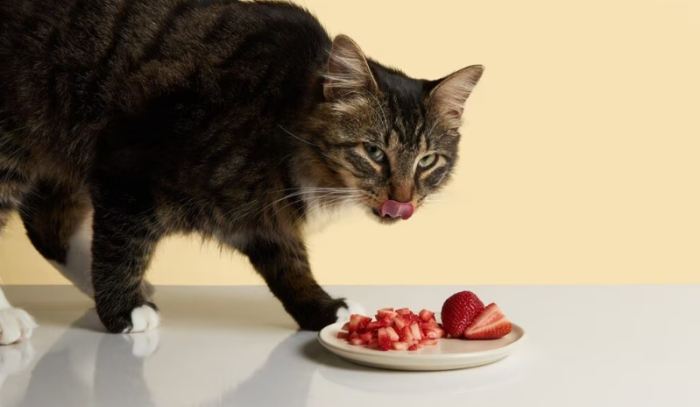
How Many Strawberries Can Cats Eat? A Guide to Portion Control
One of the most common questions I get from fellow cat owners is, “How many strawberries can cats eat?” It’s a great question because portion control is crucial when it comes to offering treats to your cat. Let’s break it down.
Start Small
When introducing strawberries to your cat for the first time, start with a very small amount. I usually give my cat just one or two pieces of strawberry to see how she reacts. This helps minimize the risk of digestive upset or allergic reactions.
Consider Your Cat’s Size
The amount of strawberries you can offer your cat depends on their size. Larger cats might be able to handle a few more pieces than smaller cats. But as a general rule, it’s best to keep the portion size small and infrequent.
Frequency Matters
Even if your cat enjoys strawberries and doesn’t show any adverse effects, it’s essential to limit the frequency of offering them. I usually give my cat strawberries as a treat once a week or less. This helps prevent overindulgence and keeps her diet balanced.
Table: Portion Control for Cats and Strawberries
| Cat Size | Recommended Portion Size | Frequency |
|---|---|---|
| Small (Under 5 lbs) | 1-2 pieces | Once a week or less |
| Medium (5-10 lbs) | 2-3 pieces | Once a week or less |
| Large (Over 10 lbs) | 3-4 pieces | Once a week or less |
Adjust Based on Your Cat’s Preferences
Every cat is different, and some might not be interested in strawberries at all. If your cat shows no interest in strawberries, don’t force it. There are plenty of other cat-safe treats you can offer instead. And if your cat loves strawberries but seems to have digestive issues after eating them, it’s best to avoid offering them in the future.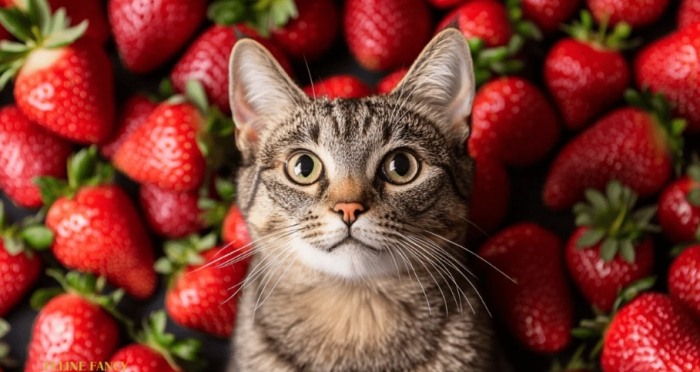
What to Do If Your Cat Eats Strawberries? Emergency Preparedness for Cat Owners
Despite our best efforts, accidents can happen. Maybe your cat sneaked a strawberry off the counter, or perhaps you gave them a piece and they had an adverse reaction. Whatever the case, it’s essential to know what to do if your cat eats strawberries.
Monitor for Symptoms
First and foremost, keep an eye on your cat for any signs of digestive upset, allergic reactions, or other adverse effects. Symptoms might include vomiting, diarrhea, itching, swelling, or difficulty breathing. If you notice any of these signs, it’s crucial to act quickly.
Contact Your Veterinarian
If your cat shows any signs of distress after eating strawberries, contact your veterinarian immediately. They can provide guidance on what to do next and whether your cat needs to be seen in person. Even if the symptoms seem mild, it’s always better to err on the side of caution.
Induce Vomiting (Only If Advised by a Vet)
In some cases, your veterinarian might advise you to induce vomiting if your cat has eaten a large amount of strawberries or if they’re showing signs of toxicity. However, this should only be done under the guidance of a professional, as inducing vomiting can be dangerous if not done correctly.
Keep Hydrated
If your cat has vomited or had diarrhea after eating strawberries, it’s essential to keep them hydrated. Offer fresh water and consider giving them a small amount of unflavored Pedialyte (if your vet approves) to help replenish electrolytes.
Learn from the Experience
After any incident where your cat eats something they shouldn’t, it’s crucial to learn from the experience. Take steps to prevent future accidents, such as keeping strawberries and other human foods out of reach. And if you’re unsure about whether a certain food is safe for your cat, always consult with your veterinarian first.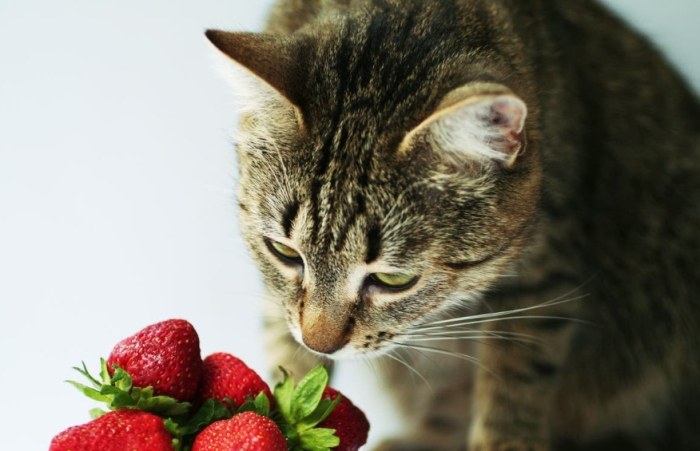
What Fruit Is Cat Safe? Exploring Alternative Treats for Your Feline Friend
Now that we’ve talked about strawberries, let’s broaden our horizons and explore what fruit is cat safe. While strawberries are one option, there are plenty of other fruits that cats can enjoy in moderation. Let’s take a look at some of the best alternatives.
Blueberries
Blueberries are small, easy to digest, and packed with antioxidants. They make a great treat for cats, especially when cut into smaller pieces. Just like strawberries, offer them in moderation and keep an eye out for any adverse reactions.
Bananas
Bananas are another cat-safe fruit, though they’re higher in sugar than some other options. Offer a small piece of banana as an occasional treat, and make sure to remove the peel first. Bananas can be a good source of potassium for cats, but again, moderation is key.
Watermelon
Watermelon is hydrating and low in calories, making it a great treat for cats during the summer months. Remove the seeds and rind first, and offer small, bite-sized pieces. Just be careful not to offer too much, as the high water content can sometimes lead to diarrhea.
Apples (Without Seeds)
Apples are a good source of fiber and vitamins for cats, but always remove the seeds and core first. Apple seeds contain cyanide, which can be toxic to cats in large amounts. Offer a small piece of apple as an occasional treat, and make sure to cut it into small, manageable pieces.
Pears (Without Seeds)
Pears are similar to apples in that they’re a good source of fiber and vitamins. Again, remove the seeds and core first, and offer small pieces as an occasional treat. Pears can be a bit softer than apples, making them easier for some cats to chew and digest.
Avoid These Fruits
While there are plenty of cat-safe fruits out there, there are also some that you should avoid at all costs. Grapes and raisins, for example, can be toxic to cats and should never be offered. Citrus fruits like oranges and lemons can also cause digestive upset and should be avoided. And always remember, what fruit is cat safe depends on the individual cat and their specific dietary needs.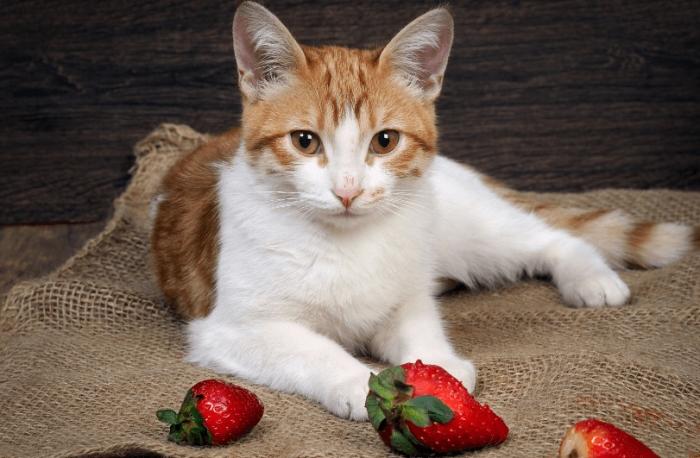
Q&A Section: Common Questions About Cats and Strawberries
Now that we’ve covered the basics, let’s tackle some common questions that fellow cat owners have about cats and strawberries.
Why Do Cats Go Crazy for Strawberries?
Cats might go crazy for strawberries because of their sweet smell, moisture content, and soft texture. However, it’s essential to remember that just because they like it doesn’t mean they should have a lot of it. Always offer strawberries in moderation and as an occasional treat.
Can Cats Eat Strawberry Leaves?
While strawberries themselves are safe for cats in moderation, strawberry leaves might not be. They can be tough to digest and might cause digestive upset. It’s best to remove the leaves and only offer the fleshy part of the strawberry to your cat.
Can Cats Eat Strawberry Yogurt?
Strawberry yogurt might seem like a tasty treat for your cat, but it’s not the best idea. Many yogurts contain added sugars, artificial flavors, and other ingredients that can be harmful to cats. Stick to plain, unsweetened yogurt if you want to offer dairy to your cat, and even then, do so in moderation.
Can Cats Eat Strawberry Ice Cream?
No, cats should not eat strawberry ice cream. Ice cream is high in sugar, dairy, and other ingredients that can be harmful to cats. Additionally, the cold temperature can be a shock to their system and might cause digestive upset. Stick to cat-safe treats instead.
What Berries Are Toxic to Cats?
While strawberries are safe for cats in moderation, there are some berries that are toxic and should be avoided at all costs. Grapes and raisins, for example, can cause kidney failure in cats. And while blackberries and raspberries are generally safe, it’s always best to offer them in moderation and keep an eye out for any adverse reactions.
Leave a Message